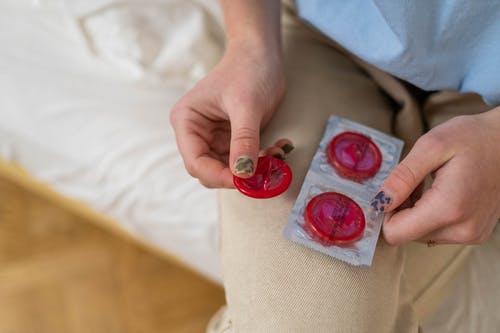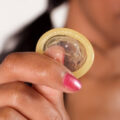Condoms are a “barrier” method of contraception. They are made of very thin latex (rubber), polyurethane, or polyisoprene and are designed to prevent pregnancy by stopping sperm from meeting an egg. They can also protect against STIs if used correctly during vaginal, anal, and oral sex.
Make sure that your penis does not touch your partner’s genital area before you have put on a condom – semen can come out of the penis before full ejaculation (you have come). If this happens, or if semen gets into your partner’s vagina during vaginal sex while using a condom, you may need emergency contraception. You should also consider having an STI test.
Types of condoms
There are 2 types of condoms:
- external condoms, worn on the penis – sometimes called male condoms
- female condoms, worn inside the vagina – sometimes called female condoms
A male condom is a tube made of latex, polyurethane, or natural membranes. The man or his partner puts the condom over the penis before the penis has any contact with the genital area. Condoms also can be used during oral or anal sex.
The condom for women (female condom) is a tube with a flexible ring at the open and closed ends. It’s made of synthetic rubber and covered in a silicone-based lubricant. You slide the closed end into your vagina and push the ring into place over the cervix. The ring at the open end should hang outside the vagina.
What is the correct way to use a condom?
- Store condoms in a cool place, out of direct sunlight. Check the expiration date on the condom wrapper or box. Condoms that are past their expiration date may break.
- Open the package carefully. Teeth or fingernails can rip the condom.
For latex male condoms:
- Put on the condom after the penis is hard. If the penis is not circumcised, pull back the foreskin before putting on the condom.
- Pinch the tip of the condom to leave a little space (about a half-inch) at the top to catch semen. Unroll the condom all the way down the penis. Add a little bit of water-based lubricant (like K-Y®, ID Glide®, and Wet®) to the outside of the condom.
- After ejaculation, hold the rim of the condom and pull out the penis while it is still hard so that no semen spills out.
- Use a new condom every time you have vaginal, anal, or oral sex.
For female condoms:
- You may insert the female condom up to eight hours before sexual intercourse.
- You should add a few drops of extra lubricant to the inside of the female condom before putting it in the vagina. Lubricant may also be added to the penis before having sex.
- Hold the female condom with the open end hanging down. Holding the outside of the condom, squeeze the inner ring with your thumb and middle finger. Put your index finger between your thumb and middle finger.
- Still squeezing the inner ring, insert the condom into the vagina. Once the condom is inside the vagina, put your index finger inside the condom and push the inner ring up as high as it will go.
- The inner ring sits above your pubic bone and holds the condom in place. The outer ring should be outside the vagina. Make sure the condom is not twisted.
- Be sure the penis enters inside the female condom and stays inside the female condom during sex. If the penis enters under or outside the condom, stop right away. Take out the condom and reinsert it.
- If the condom moves or sticks to the penis, or makes noise, add more lubricant.
- After sex, just twist the outer ring to keep semen inside the condom and pull it out gently.
- Use a new condom every time you have sex.
How Effective Are Condoms?
While very important for preventing sexually transmitted diseases or infections, this is one of the least effective methods for preventing pregnancy. It has one of the highest pregnancy rates of all birth control methods.
About 13 out of 100 women using only male condoms for birth control get pregnant in a year of use.
- Condoms that are factory-coated with spermicide don’t prevent pregnancy any better than regular condoms.
- The most common reason for failure is not using a condom every time. Condoms may also break or slip.
Female condoms are one of the least effective forms of birth control. It has one of the highest pregnancy rates of all birth control methods. About 21 out of 100 women using female condoms get pregnant in a year of use.
Male condoms are considered the safest and overall effective form of birth control. According to Planned Parenthood, condoms are 98 percent effective at preventing pregnancy when used correctly. If used incorrectly, the effectiveness rate drops to about 85 percent.
Do male and female condoms provide the same protection against HIV?
Yes. Studies show that female condoms are as effective at protecting against HIV as male condoms. Female condoms are made of nitrile, which is an effective barrier to HIV. Male and female condoms should not be used at the same time. Female condoms, like latex male condoms, are available in some drug stores, community health centers, and AIDS service organizations.
Does spermicide provide additional protection against HIV?
You should not use additional or separate applications of spermicide for HIV prevention during vaginal or anal sex. Women who use spermicidal cream or jelly for pregnancy prevention should also use a condom to protect against HIV and to provide better protection against pregnancy than spermicide alone.
Spermicides contain the chemical nonoxynol-9 (N-9). Although N-9 kills HIV in test tubes, one study showed that N-9 inserted into the vagina may irritate the vagina and actually increase the risk of HIV infection during vaginal sex. N-9 may also irritate the lining of the rectum and should not be used for anal sex.
Some condoms are pre-lubricated with a lubricant containing N-9. These condoms still provide greater protection against HIV than not using a condom. However, a lubricated condom without N-9 may be the best for HIV prevention.
Can condoms provide protection from sexually transmitted diseases (STDs), including HIV?
Yes. Whether you use latex male condoms or female condoms, they are both very effective in preventing HIV and many other STDs when used the right way every time. Condoms may prevent the spread of other STDs, like the Human Papillomavirus (HPV, genital or venereal warts) or genital herpes, only when the condom covers the infected areas or sores. To find out if you might have an STD, visit your doctor or clinic as soon as you can.
Is there a 100% effective way to prevent sexual transmission of HIV and STDs?
The only 100% effective way to prevent sexual transmission of HIV and STDs is through abstinence – avoiding all vaginal, anal and oral sex. Using a latex male condom or a female condom can greatly reduce, but not entirely eliminate, the risk of HIV and STD transmission. Abstinence is the only method to completely eliminate the possibility of sexual transmission of HIV or STDs.
Do birth control methods other than condoms reduce the risk of STDs including HIV?
No. Only condoms reduce the risk of pregnancy, STDs, and HIV. Birth control pills, the birth control patch, contraceptive injections such as Depo-Provera, intrauterine devices (IUDs), diaphragms, and any birth control methods other than condoms do not provide protection against STDs and HIV. You should use a latex male condom or a female condom for STD and HIV prevention along with any other method you use to prevent pregnancy. Condoms can prevent the spread of other STDs, like HPV or genital herpes, only when the condom covers all of the infected areas or sores.






